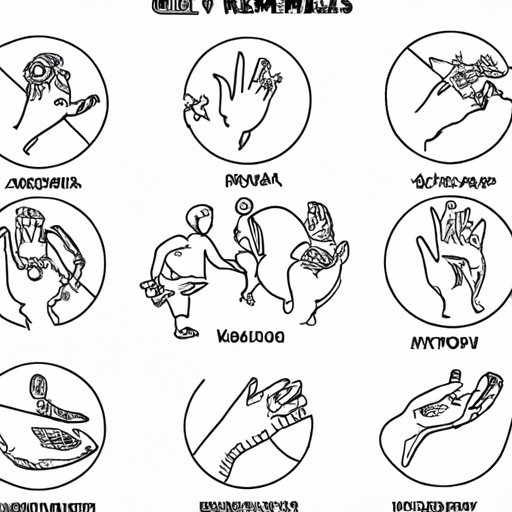
Introduction
Hand, foot, and mouth disease is a highly contagious viral illness that commonly affects infants and young children. However, it can also affect adults. The disease gets its name from the blisters and sores that can develop on the hands, feet, and mouth. In this article, we will discuss whether it is possible to get hand, foot, and mouth disease more than once. This article is intended for parents, caregivers, and anyone interested in learning more about the likelihood of acquiring the disease again.
Symptoms
The symptoms of hand, foot, and mouth disease can vary from person to person. Generally, the symptoms can range from mild to severe and can take up to ten days to appear after exposure to the virus. Common symptoms include fever, sore throat, a feeling of malaise, and painful sores in the mouth. Other symptoms can include a rash or blisters on the hands, feet, and buttocks.
It is important to identify the symptoms of hand, foot, and mouth disease early, as this can help improve outcomes and prevent complications. If you suspect you or your child has symptoms of the disease, you should consult a healthcare professional.
Causes and Transmission
Hand, foot, and mouth disease is caused by a group of viruses called enteroviruses. There are many strains of enteroviruses, but most cases of hand, foot, and mouth disease are caused by the Coxsackie A virus. The virus typically spreads through close personal contact with someone who has the infection or by coming into contact with surfaces contaminated with the virus.
The virus is highly contagious and can spread easily during outbreaks. The most common ways the virus is transmitted are through coughing, sneezing, and contact with contaminated surfaces, such as toys or doorknobs. Young children and infants are at a higher risk of contracting the virus due to their developing immune systems and propensity to put objects in their mouths.
Likelihood of Getting the Virus More Than Once
While most people who contract hand, foot, and mouth disease develop immunity against the virus, it is possible to get the virus more than once. This is because there are many strains of the virus, and immunity to one strain does not necessarily provide immunity to other strains.
Additionally, immunity to the virus may not last indefinitely. A person’s immune system may not generate enough antibodies to protect against a subsequent infection or may wane over time. A study published in the Journal of Virology found that immunity to the Coxsackie A virus wanes over time and may not offer complete protection against reinfection.
Immunity After Recovery
Most people who recover from hand, foot, and mouth disease are typically immune to the virus for a period of time. According to the Centers for Disease Control and Prevention (CDC), immunity to the virus can last anywhere from a few months to several years.
However, in some cases, individuals can become carriers of the virus even after they have recovered. These individuals may not show any symptoms but can still spread the virus to others through close personal contact or contaminated surfaces.
Remedies and Tips for Easing the Discomfort and Pain
Hand, foot, and mouth disease can cause significant discomfort and pain, especially among young children. Fortunately, there are several remedies and tips that can help ease the symptoms of the disease. These include:
– Drinking fluids to prevent dehydration
– Taking over-the-counter pain medication, such as acetaminophen or ibuprofen
– Eating cold, soft foods to soothe mouth sores
– Rinsing the mouth with a saltwater solution to promote healing
– Applying a cool, damp cloth to affected areas to alleviate pain and irritation
– Getting plenty of rest to promote healing
Risk Factors and Prevention
The risk factors for hand, foot, and mouth disease include close personal contact with someone who has the virus, being in places with large crowds, and living in areas with poor sanitation. To minimize your chances of contracting the virus, it is important to practice good hygiene, such as washing your hands frequently, especially after coming into contact with someone who has the virus.
Additionally, to prevent the spread of the virus, you should avoid close contact with someone who has the virus, disinfect contaminated surfaces, and avoid sharing utensils or cups.
Myths and Misconceptions Surrounding the Disease
There are several myths and misconceptions surrounding hand, foot, and mouth disease. One common misconception is that the disease is related to foot and mouth disease, a disease that affects livestock. However, the two diseases are not related, and it is not possible for humans to catch foot and mouth disease from animals.
Another myth is that hand, foot, and mouth disease can be prevented through vaccination. Currently, there is no vaccine available for the disease. The best way to prevent the disease is through good hygiene practices.
Conclusion
Hand, foot, and mouth disease is a highly contagious viral infection that can cause significant discomfort and pain in affected individuals. It is possible to contract the disease more than once due to the many strains of the virus and the potential waning of immunity over time. The best way to prevent the disease is to practice good hygiene, avoid close contact with infected individuals, and disinfect contaminated surfaces. By remaining vigilant and taking appropriate precautions, individuals can reduce their risk of contracting the virus and help prevent outbreaks.




